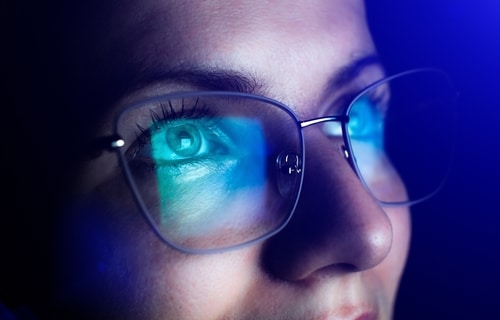In today’s world, we are surrounded by digital screens. We spend hours staring at screens every day, from smartphones to laptops, TVs, and tablets. However, this constant exposure to blue light emitted by digital screens can significantly impact our eye health. In this blog, we’ll discuss the effects of blue light on eye health and how to protect yourself from its harmful effects.
What is Blue Light?
Blue light is a high-energy visible (HEV) light that has a shorter wavelength and higher frequency than other colors on the visible light spectrum. The sun emits blue light, but digital screens, LED, and fluorescent lights also emit it. While blue light is essential for regulating our circadian rhythm and boosting our mood and alertness, excessive exposure can harm our eyes.
The Effects of Blue Light on Eye Health
Blue light can cause several eye health issues, including:
Digital Eye Strain (DES): Digital Eye Strain is a common condition caused by prolonged use of digital screens. Symptoms include headaches, blurred vision, dry eyes, and neck and shoulder pain.
Sleep Disorders: Blue light can interfere with our circadian rhythm and suppress melatonin production, a hormone that regulates sleep. Exposure to blue light at night can disrupt our sleep patterns and make it difficult to fall asleep.
Age-related Macular Degeneration (AMD): Blue light can penetrate deep into the eye and cause damage to the retina. Studies have linked blue light exposure to the development of age-related macular degeneration, a condition that causes vision loss in older adults.
Cataracts: Blue light exposure can also increase the risk of cataracts, a clouding of the eye’s natural lens that can cause vision loss.
How to Protect Yourself from Blue Light
Use Blue Light Blocking Glasses: Blue light-blocking glasses are specially designed to block blue light emitted by digital screens. They can help reduce eye strain and improve sleep quality. Investing in a pair of blue light-blocking glasses can be beneficial if you spend several hours a day in front of a screen.
Take Frequent Breaks: The 20-20-20 rule can help reduce eye strain. Every 20 minutes, take a 20-second break and look at something 20 feet away. This can help relax your eye muscles and reduce eye strain.
Adjust Screen Settings: Most digital devices have settings that allow you to adjust your screen’s brightness and color temperature. Reducing the brightness and changing the color temperature to a warmer tone can help reduce blue light exposure.
Use Anti-glare Filters: Anti-glare filters can help reduce the amount of blue light that reflects off your screen and into your eyes.
Reduce Screen Time: Reducing your overall screen time can help reduce your exposure to blue light. Take breaks from your screen and engage in other activities that don’t require digital screens.
Conclusion
In conclusion, blue light can significantly impact our eye health. Excessive exposure to blue light can cause digital eye strain and sleep disorders and increase the risk of age-related macular degeneration and cataracts. However, by taking steps to protect ourselves, such as using blue light-blocking glasses, taking frequent breaks, adjusting screen settings, and reducing overall screen time, we can reduce our exposure to blue light and protect our eye health.

